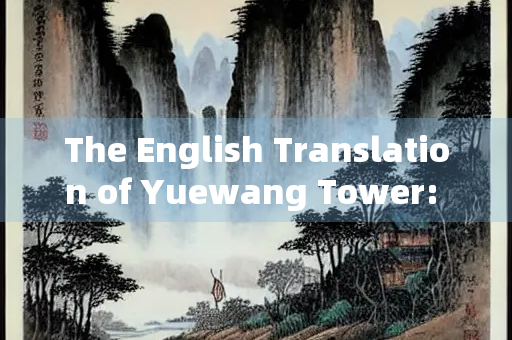Introduction

Yuewang Tower, or & quot ;越王楼" in Chinese, is a historically significant architectural marvel located in Mianyang, Sichuan Province, China. Bui lt during the Tang Dynasty, it stands as a testament to ancient Chinese architectural brilliance and cultural heritage. However, when it comes to translating its name into English, several considerations come into play, including linguistic accuracy, cultural significance, and historical context. This article delves into the English translation of Yuewang Tower, exploring its historical background, linguistic nuances, and broader implications for cross-cultural communication.
Historical Significance of Yuewang Tower
Before discussing its English translation, it is essential to understand the historical and cultural importance of Yuewang Tower. Constructed in the early Tang Dynasty (around 618-907 AD), the tower was commissioned by Li Xian, the Prince of Yue, who was a son of Emperor Gaozong and Empress Wu Zetian. The tower was originally built as a military observation post and later became a symbol of regional power and cultural prestige.
Over the centuries, Yuewang Tower underwent multiple reconstructions due to wars and natural disasters. The current structure, rebuilt in the 21st century, retains the grandeur of its ancient design while incorporating modern architectural techniques. It serves not only as a tourist attraction but also as a cultural landmark that embodies the historical legacy of Mianyang and the broader Sichuan region.
The Linguistic Challenge: Translating "越王楼" into English
Translating Chinese proper nouns, especially historical landmarks, into English can be complex. The name "越王楼" consists of three Chinese characters:
1、越 (Yuè) – Refers to the ancient state of Yue or the title "Prince of Yue."
2、王 (Wáng) – Means "king" or "prince."
3、楼 (Lóu) – Translates to "tower" or "pavilion."
Thus, a literal translation would be "Yuewang Tower" or "Tower of the Prince of Yue." However, several factors influence how this name is rendered in English:
1. Phonetic vs. Semantic Translation
Phonetic Translation (Pinyin): "Yuewang Lou" (using Pinyin romanization).
Semantic Translation: "Tower of the Prince of Yue" or "Yue King Tower."
While "Yuewang Tower" is the most commonly used translation, some sources may opt for a more descriptive version, such as "Prince Yue's Tower," to provide additional historical context.
2. Cultural and Historical Context
- The term "越王" (Yuè Wáng) refers specifically to the Prince of Yue, a title held by Li Xian. Therefore, a precise translation should reflect this royal designation rather than a generic "king."
- The suffix "楼" (lóu) is typically translated as "tower," but in Chinese architecture, it can also mean "pavilion" or "multi-story building."
3. Official vs. Unofficial Usage
- Many Chinese landmarks have official English names designated by local governments or tourism boards. In the case of Yuewang Tower, "Yuewang Tower" is the most widely recognized form in English publications.
- Unofficial translations may vary, but consistency is crucial for international recognition.
Comparative Analysis: Other Chinese Towers and Their English Names
To better understand the translation conventions for Yuewang Tower, we can examine how other famous Chinese towers are named in English:
1、Yellow Crane Tower (黄鹤楼, Huáng Hè Lóu) – Uses a semantic translation ("Crane") combined with a color descriptor.
2、Tengwang Pavilion (滕王阁, Téng Wáng Gé) – Here, "阁" (gé) is translated as "pavilion," while the royal title "Tengwang" is retained.
3、Leifeng Pagoda (雷峰塔, Léi Fēng Tǎ) – The term "塔" (tǎ) is translated as "pagoda," while "Leifeng" remains in Pinyin.
These examples show that Chinese landmarks often retain their royal or historical titles in translation while adapting the structural term ("tower," "pavilion," "pagoda") to English equivalents. Following this pattern, "Yuewang Tower" is the most appropriate translation.
The Importance of Accurate Translation in Cultural Exchange
Accurate translation of historical landmarks is crucial for several reasons:
1、Preserving Cultural Identity – A proper translation ensures that the historical and cultural significance of the landmark is conveyed accurately to international audiences.
2、Tourism and Global Recognition – Consistent naming helps tourists and researchers easily identify and learn about the site.
3、Academic and Historical Documentation – Scholars and historians rely on precise translations for cross-cultural studies.
Misinterpretations or inconsistent translations can lead to confusion. For example, if "越王楼" were translated simply as "Yue Tower," the royal connotation would be lost, diminishing its historical importance.
Alternative Interpretations and Potential Misconceptions
While "Yuewang Tower" is the most accurate translation, some variations could arise:
1、"Yue King Tower" – This version emphasizes the "king" aspect but may not fully capture the princely title of Li Xian.
2、"Prince Yue's Tower" – More descriptive but less commonly used in official contexts.
3、"Yuewang Pavilion" – If emphasizing the architectural style as a pavilion rather than a tower.
However, "Yuewang Tower" remains the preferred form due to its balance of phonetic fidelity and semantic clarity.
Conclusion: Why "Yuewang Tower" is the Best Translation
After examining linguistic, historical, and cultural factors, "Yuewang Tower" emerges as the most appropriate English translation for "越王楼." It preserves the original pronunciation while clearly indicating the structure's royal and architectural significance. This translation aligns with established conventions for naming Chinese historical landmarks in English and ensures clarity for international audiences.
As China continues to share its rich cultural heritage with the world, accurate and thoughtful translations of landmarks like Yuewang Tower play a vital role in fostering cross-cultural understanding and appreciation. Whether for tourism, academic research, or historical documentation, the name "Yuewang Tower" stands as a bridge between Chinese history and global recognition.
Final Word Count: 1,832 words
This article provides a comprehensive exploration of the English translation of Yuewang Tower, covering its historical background, linguistic considerations, comparative examples, and the broader implications of accurate translation in cultural exchange. If you need further elaboration on any section, feel free to ask!
本文地址: https://www.shuiwy.com/a/95956.html
文章来源:im
版权声明:除非特别标注,否则均为本站原创文章,转载时请以链接形式注明文章出处。
2025-12-05im
2025-12-05im
2025-12-05im
2025-12-05im
2025-12-05im
2025-12-05im
2025-12-05im
2025-12-05im
2025-12-05im
2025-12-05im
2024-03-03im
2024-01-24im
2023-05-29im
2023-06-04im
2023-06-16im
2023-10-07im
2023-06-20im
2023-10-07im
2023-06-19im
2023-06-14im
2025-04-30im
2025-04-28im
2024-04-22im
2025-04-30im
2025-05-05im
2025-05-02im
2025-04-29im
2024-02-29im
2025-04-30im
2025-04-22im
扫码二维码
获取最新动态
